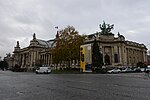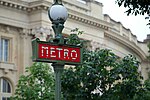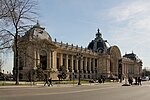Grand Palais

The Grand Palais des Champs-Élysées, commonly known as the Grand Palais (English: Great Palace), is a historic site, exhibition hall and museum complex located at the Champs-Élysées in the 8th arrondissement of Paris, France. Construction of the Grand Palais began in 1897 following the demolition of the Palais de l'Industrie (Palace of Industry) to prepare for the Universal Exposition of 1900. That exposition also produced the adjacent Petit Palais and Pont Alexandre III.The building was designed to be a large-scale venue for official artistic events. A pediment on the building refers to this function with an inscription that reads, "a monument dedicated by the Republic to the glory of French art." Designed according to Beaux-Arts tastes, the building features ornate stone facades, glass vaults and period innovations that included iron and light steel framing and reinforced concrete.It is listed as a historic monument (monument historique) by the Ministry of Culture.
Excerpt from the Wikipedia article Grand Palais (License: CC BY-SA 3.0, Authors, Images).Grand Palais
Avenue du Général Eisenhower, Paris 8th Arrondissement of Paris (Paris)
Geographical coordinates (GPS) Address Phone number Website External links Nearby Places Show on map
Geographical coordinates (GPS)
| Latitude | Longitude |
|---|---|
| N 48.866111111111 ° | E 2.3125 ° |
Address
Grand Palais
Avenue du Général Eisenhower
75008 Paris, 8th Arrondissement of Paris (Paris)
Ile-de-France, France
Open on Google Maps










